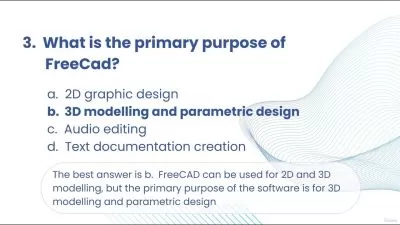Applied Mechanics for Engineering Students
Baskar P
4:31:24
Description
A Foundation Course to become an expert in Applied Mechanics-with Regular Updates
What You'll Learn?
- Learn equilibrium of rigid bodies
- Understand statics and dynamics of rigid bodies
- Learn statics and dynamics of fluids
- Understand the mechanics of materials
Who is this for?
What You Need to Know?
More details
DescriptionWhat is Applied Mechanics?
Applied Mechanics is a branch of science that deals with the effect of external forces acting on an object at rest or in motion.
Why is Applied Mechanics important?
Applied Mechanics plays a vital role in the design of structures and machine elements. It is the fundamental subject for engineering solutions related to architecture, civil engineering, mechanical engineering, and so on.
What will you gain from this course?
This course covers the following:
fundamental concepts, equilibrium of particles, equilibrium of rigid bodies, different types of beams, supports and reactions, center of gravity, moment of inertia, friction, and their importance
Basic Concepts of Engineering Mechanics: Outline of Engineering Mechanics, definition, and scope.
Equilibrium of Particles: Principle of Superposition of Forces, Resolution of Forces, Parallelogram Law of Forces, Lami's Theorem, Equilibrium of a Particle, and Free-body Diagram.
Equilibrium of Rigid Bodies: Internal Forces, External Forces, and Principle of Transmissibility, Moment of a Force-Concept; Varignon's Theorem and Couple, Resolution of a force into force and couple system of forces
Beams, Supports, and Reactions: Free-body Diagram, Equilibrium, and Conditions of Equilibrium, and determination of support reactions.
Centroid and Centre of Gravity: Important Definitions, Determination of center of gravity of Plane Figures.
Moment of Inertia: Second Moment of Area-Introduction and MOI for Simple Configurations, and Moment of Inertia of Composite Plane Sections.
This course also includes solved numerical examples, interactive quizzes, and assignments/exercises in each section for self-evaluation.
The numerical examples are solved in a step-by-step process, explained with clear concepts so that the students will be able to understand without any ambiguity.
Also, this course provides downloadable study materials in pdf format for future reference. The exercises are solved and provided with the answers.
What support will you get?
You will get answers to your questions, doubts, and clarifications within 36 hours of submitting your queries, get additional resources within 96 hours, and regular updates twice a month.
Who this course is for:
- Science, Engineering and Technology students
- Anyone who is interested and having a minimum knowledge of Basic Maths and Physics
What is Applied Mechanics?
Applied Mechanics is a branch of science that deals with the effect of external forces acting on an object at rest or in motion.
Why is Applied Mechanics important?
Applied Mechanics plays a vital role in the design of structures and machine elements. It is the fundamental subject for engineering solutions related to architecture, civil engineering, mechanical engineering, and so on.
What will you gain from this course?
This course covers the following:
fundamental concepts, equilibrium of particles, equilibrium of rigid bodies, different types of beams, supports and reactions, center of gravity, moment of inertia, friction, and their importance
Basic Concepts of Engineering Mechanics: Outline of Engineering Mechanics, definition, and scope.
Equilibrium of Particles: Principle of Superposition of Forces, Resolution of Forces, Parallelogram Law of Forces, Lami's Theorem, Equilibrium of a Particle, and Free-body Diagram.
Equilibrium of Rigid Bodies: Internal Forces, External Forces, and Principle of Transmissibility, Moment of a Force-Concept; Varignon's Theorem and Couple, Resolution of a force into force and couple system of forces
Beams, Supports, and Reactions: Free-body Diagram, Equilibrium, and Conditions of Equilibrium, and determination of support reactions.
Centroid and Centre of Gravity: Important Definitions, Determination of center of gravity of Plane Figures.
Moment of Inertia: Second Moment of Area-Introduction and MOI for Simple Configurations, and Moment of Inertia of Composite Plane Sections.
This course also includes solved numerical examples, interactive quizzes, and assignments/exercises in each section for self-evaluation.
The numerical examples are solved in a step-by-step process, explained with clear concepts so that the students will be able to understand without any ambiguity.
Also, this course provides downloadable study materials in pdf format for future reference. The exercises are solved and provided with the answers.
What support will you get?
You will get answers to your questions, doubts, and clarifications within 36 hours of submitting your queries, get additional resources within 96 hours, and regular updates twice a month.
Who this course is for:
- Science, Engineering and Technology students
- Anyone who is interested and having a minimum knowledge of Basic Maths and Physics
User Reviews
Rating
Baskar P
Instructor's Courses
Udemy
View courses Udemy- language english
- Training sessions 47
- duration 4:31:24
- Release Date 2023/08/19
















